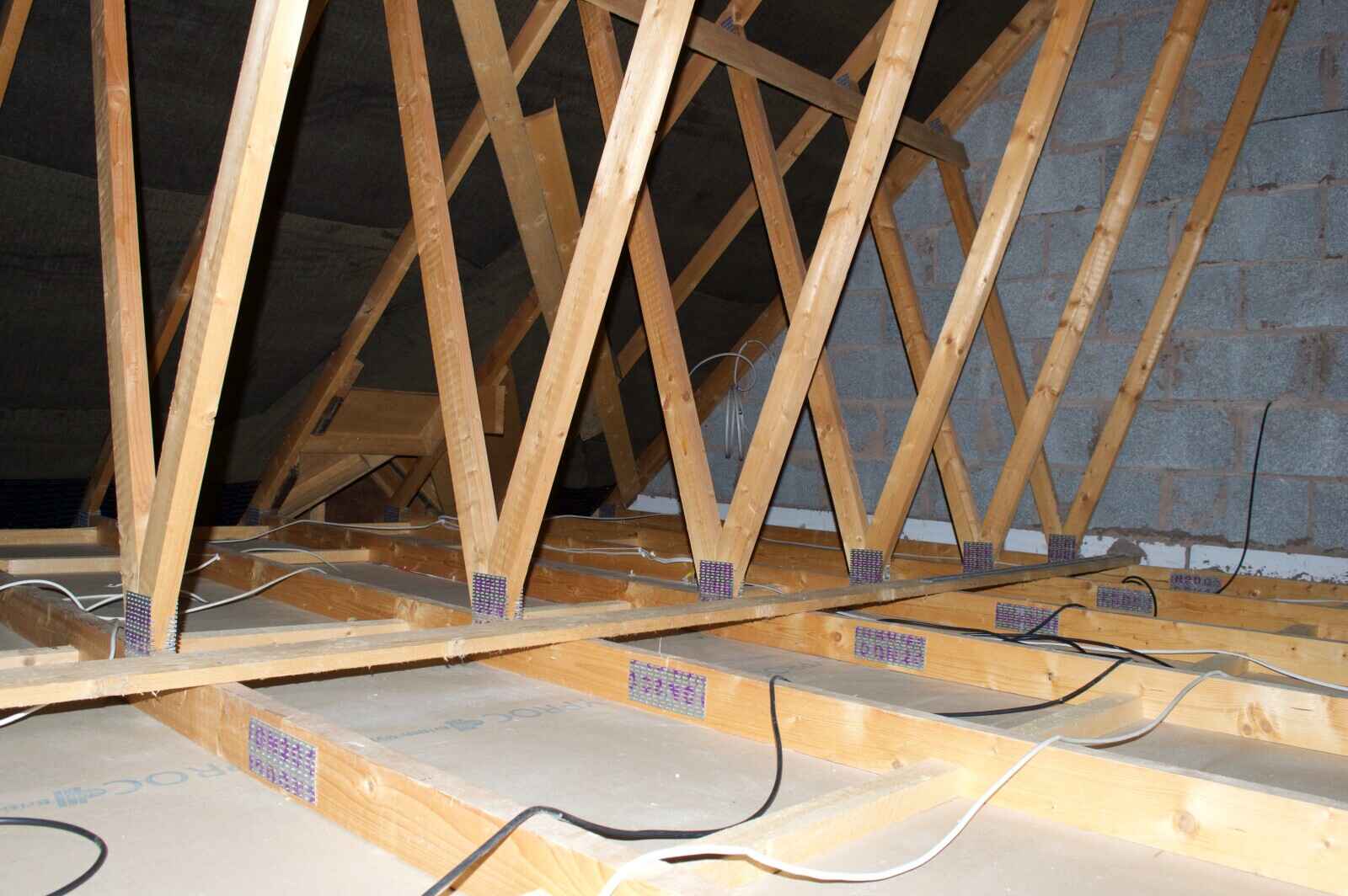Attic Insulation R-Value: The Un-Handyman's Guide
You Can Judge The Quality Of Attic Insulation Based On Its R-Value, But What The Heck Is Attic Insulation's R-Value? Here Is A Guide For The Non-Handyman.
- What Does R-Value Mean?
- What Is Your Climate?
- Best Options For Your Attic Insulation
- Calculating the Ideal R-Value for Your Attic
- Common Misconceptions About Attic Insulation
- Thicker Insulation Is Always Better:
- All Insulation Types Are the Same:
- Insulation Lasts Forever:
- DIY Always Saves Money:
- DIY vs. Professional Installation: What's Right for You?
- Beyond R-Value: Other Factors to Consider in Attic Insulation
- Insulation Age
- Construction Materials
- Occupancy
- Ventilation
- Energy Efficiency Upgrades
- Eco-Friendly Insulation Options for Attics
- Cost Considerations: Balancing Efficiency and Affordability
- Final Thoughts
You can judge the quality of attic insulation based on its R-value, but what the heck is attic insulation's r-value? Here is a guide for the non-handyman.
So you know you need to insulate your attic space properly, but now there are many decisions to make.
What type of home insulation? How much insulation do I need? What is the ideal attic insulation R-value? Wait, what does R-value mean again?
Researching strategies to enhance the insulation in attics is a worthy investment of time, and the best place to begin is by learning about R-values for insulation.
What Does R-Value Mean?
You use the R-value when determining the amount of insulation your house requires. The R in R-value means resistance and is used to quantify the heat resistance of insulation materials.
The R-value measures a material's resistance to heat flow, with higher insulation R-values indicating more resistance. Temperature differences cause energy to move from hot to cold to find a stable temperature balance.
This indicates that your home's heat attempts to escape throughout the winter. Increasing insulation levels may use less energy to keep your house warm. Energy efficiency, decreased heat loss, and lower utility expenses are a consequence.
In warmer climates, the outside air can easily heat your house. Proper insulation on your home's floors, exterior walls, crawl spaces, and particularly in the attic is vital to keep cooling expenses and heat transfer at a minimum.
You'll need to determine where to put insulation in your house since various sections need different R-values. Because heat naturally rises and exits via your attic, the attic requires greater than a wall insulation R-value.
Then, when you've determined your zone (more of this below) and where you will place your insulation, look at your alternatives and the many kinds of insulation available to you.
Even though there's a lot to take in, you won't be doing this alone. What R-value for the attic insulation, the correct quantity of insulation, and more may all be explained to you by a certified attic specialist.
What Is Your Climate?
Depending on the climate zone, the US Department of Energy has recommended R-values for different types of insulation.
The United States Department of Energy maintains an insulation R-value chart that illustrates the suggested R-value range for each area of the nation. For example, homeowners in the southern United States can begin insulating their attic using materials that have R-values in the R30 to R60 range and R13 to R19 insulation ratings for the floors.
Attic insulation should be R49-R60, while floor insulation should be R25-R30 for those in the north of the United States. Insulation material with a minimum R-value can be an option if you only install more on top of the insulation installed.
We might benefit from adding insulation to our homes, even if it isn't at the top of our to-do lists. According to the Department of Energy (DOE), most American houses have inadequate insulation. It can save ten percent annually on energy costs by adding adequate R-value insulation and sealing air leaks throughout the house.
Certified attic specialists can give general guidance on determining how much insulation you need depending on the size of your home, the kind of heating and cooling systems you have, and where you reside.
Best Options For Your Attic Insulation
For each use, a certain kind of insulation is more appropriate than another. The most prevalent forms of insulation are listed here in R-values.
- Blown-in fiberglass - What insulation to use for walls? Blown-in or loose-fill fiberglass insulation is excellent for houses requiring additional insulation since it is blown loosely into the attic space and securely into the attic walls. In terms of R-value, it ranges from 2.2 to 4.3 per inch, depending on the density of the material.
- Fiberglass batts - Certified attic specialists install them on wall studs before applying the final surfaces to new homes, giving excellent insulation and air-sealing performance. Between 3.1 and 3.4 R-value per inch is typical for fiberglass batts. A fantastic alternative to fiberglass batt insulation is rigid foam board.
- Spray foam - Applying spray foam fills in the gaps and any holes or cavities. The insulation and air-sealing performance of spray foam insulation is more remarkable when used in new construction. Still, certified attic specialists may also use them during a major remodeling project. In open-cell spray foam installations, the typical R-value ranges from 3.5 to 3.6; in closed-cell spray foam installations, the average ranges from 6.0 to 6.5.
- Cellulose - When blown into walls and used as ceiling insulation, cellulose insulation provides additional insulation without requiring major renovations. Cellulose wall and ceiling insulation R-values are 3.2 to 3.9, depending on how densely it is packed after installation, providing good insulation and air sealing efficiency.
Calculating the Ideal R-Value for Your Attic
Determining the ideal R-value for your attic insulation is critical in ensuring that your home remains energy-efficient and comfortable. To achieve this, follow a systematic approach:
Consider your geographical location and climate zone, then assess the size of your home. Larger homes often require more insulation to maintain consistent temperatures. Measuring the square footage of your attic space provides a rough estimate of the insulation quantity needed.
Factor in the type of heating and cooling systems in your home. More efficient systems may demand less insulation to achieve desired comfort levels, while older systems may require more insulation to compensate for inefficiencies.
Evaluate any existing insulation in your attic. If you already have insulation in place, assess its condition and R-value. It's often possible to improve insulation efficiency by adding new layers on top of existing ones.
For a precise recommendation, it's advisable to consult a certified attic specialist. They can thoroughly assess your attic, taking all relevant factors into account, and provide expert guidance on the ideal R-value for your specific situation. Remember that achieving the right R-value is essential for energy efficiency and overall comfort, making this calculation a worthwhile investment of time and effort.
Common Misconceptions About Attic Insulation
Several misconceptions surround attic insulation that can lead to incorrect R-value choices:
Thicker Insulation Is Always Better:
While increasing insulation thickness is important to a certain extent, excessive insulation can trap moisture, leading to issues like mold and rot.
All Insulation Types Are the Same:
Different insulation types have unique properties and R-values, so choosing the right one for your specific needs and climate is crucial.
Insulation Lasts Forever:
Over time, insulation can settle or deteriorate, reducing its effectiveness. Periodic inspection and maintenance are essential.
DIY Always Saves Money:
While DIY insulation projects can be cost-effective, they may lack the expertise needed for optimal results. Professional installation can save energy and money in the long run.
DIY vs. Professional Installation: What's Right for You?
When it comes to attic insulation, you have two main options: DIY or professional installation.
DIY Attic Insulation offers the benefits of cost savings on labor, suitability for small projects, and flexibility in scheduling. However, it may lack the expertise for proper R-value calculations, carry a risk of improper installation, and limit access to professional equipment and materials.
Professional Attic Insulation, on the other hand, ensures an accurate R-value assessment, expertise in insulation types and installation techniques, and guaranteed quality and efficiency. However, it comes with a higher upfront cost, requires scheduling and coordination with professionals, and may have a lead time for appointments.
Choosing between DIY and professional installation depends on your budget, time constraints, and your confidence in your skills. Hiring a certified attic specialist is often the more efficient and effective option for larger projects or when unsure about calculations.
Beyond R-Value: Other Factors to Consider in Attic Insulation
Effective attic insulation encompasses more than just R-value. Homeowners should also consider the following factors:
Insulation Age
Regularly inspect and replace insulation as needed to maintain efficiency, as it can deteriorate over time.
Construction Materials
Older homes with less efficient construction may require higher R-values to compensate for heat loss.
Occupancy
The number of occupants affects heat generation and insulation needs, with larger families potentially requiring more insulation.
Ventilation
Proper attic ventilation is crucial to prevent moisture buildup and maintain insulation integrity, preventing issues like mold and rot.
Energy Efficiency Upgrades
Combine attic insulation with other energy-efficient upgrades, such as sealing air leaks, upgrading windows and doors, and improving ductwork, to maximize energy savings.
Eco-Friendly Insulation Options for Attics
When it comes to attic insulation, homeowners are increasingly considering eco-friendly options that enhance energy efficiency and minimize environmental impact. Several sustainable materials have gained popularity, offering an eco-conscious alternative to traditional insulation. These materials include recycled denim, wool, and cellulose insulation.
Recycled denim insulation, made from post-consumer jeans, is a creative way to repurpose old clothing and a highly efficient insulator. It boasts excellent thermal performance and sound absorption properties and is free from harmful chemicals.
Wool insulation, derived from sheep's wool, is a renewable and biodegradable option known for its natural fire resistance and moisture-wicking capabilities. Cellulose insulation is composed of recycled paper and treated to be fire-resistant and insect-repellent, making it a green choice.
Choosing these sustainable insulation materials contributes to a more energy-efficient home and supports environmentally responsible practices.
Cost Considerations: Balancing Efficiency and Affordability
Cost plays a significant role in the decision-making process when considering attic insulation. Balancing insulation efficiency with budget constraints is crucial to make informed choices. The cost factors associated with different types of attic insulation include material cost, installation labor, and long-term energy savings.
Fiberglass batts and blown-in fiberglass are cost-effective options, offering reasonable R-values at a budget-friendly price point. While more expensive upfront, spray foam insulation provides excellent insulation performance and potential long-term savings due to its high R-value and air-sealing properties.
To find the right balance, assessing your specific needs and budget is essential. Conduct a cost-benefit analysis that considers the initial investment and the potential energy savings over the insulation's lifespan. Additionally, explore available rebates, tax incentives, and financing options that can help offset upfront costs.
Consulting with insulation professionals can also provide valuable insights into achieving optimal efficiency while staying within your budgetary limits. Ultimately, the goal is to strike a balance that ensures a comfortable and energy-efficient home without breaking the bank.
Final Thoughts
Using a higher R-Value as the sole criterion for good insulation is not a good idea. There are several elements to consider when deciding on the best insulation for your attic and house, including its age, location, and construction materials. Another issue to consider is the installation cost and the number of people living in your home. You can rely on certified attic specialists for any insulation installation, no matter how complex.

